< Previous | Contents | Next >
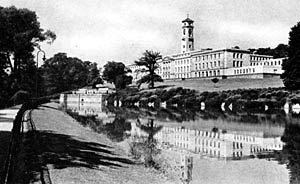
The Portland Building at Nottingham University in the late 1930s.
Nearly two miles from the great Council House and the historic castle is Nottingham's beautiful University college, rising on a green hill by the Boulevard named after it. It has one of the loveliest towers in the Midlands, crowning a building of great beauty, which was one of the life-dreams of a poor Nottingham boy who became a prince of commerce. The story goes far back, and has in it something of pride and pathos and tragedy.
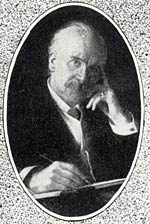
Jesse Boot.
About the middle of last century a little boy named Jesse Boot stood behind the counter with his mother in a herbalist's shop started by his father, in a street leading into Nottingham from Sneinton. And about the same time two of Nottingham's leading citizens, Dr J. B. Paton and Richard Enfield, had "the bold idea that Oxford and Cambridge could throw out their arms to reach beyond the bounds of their walls, and it was to Nottingham that Cambridge sent out the first lecturers in connection with the University Extension Movement. Nottingham was the first town in England to maintain a University College out of the rates, and it was fitting that it should start this great development of university life. This seed was being sown when Jesse Boot and his widowed mother were working hard in their little shop in Hockley. He was building up his business; the educators were opening the way he was to go when he had done with his 800 shops and wanted something more to build.
The idea behind the education movement in Nottingham was to build up an East Midland University, and it began with University College, the old buildings of which are still used for textile and mining and law departments, and for all the evening classes. They stand near the heart of the town, and have done fine work for half a century, but it was not enough. Then, to make every struggle in this world a little harder, came the Great War, and it seemed that the dream was broken.
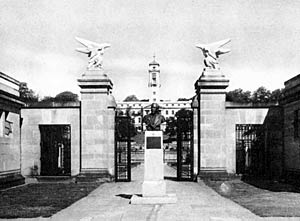
The entrance to Nottingham University in the late 1930s.
But it was with the Great Peace that Sir Jesse Boot came on the scene. He had grown rich and famous, but all his wealth and all his fame he would have given for good health. Rheumatoid arthritis had him in its grip; his body failed him more and more. He lay on his back day and night, unable to move alone, but with a mind alert and dreaming of doing some great new thing. What he did was to build this University College, one of the finest monuments learning has. It rises from its mantle of trees at Highfields with the graciousness and elegance of a beautiful white lady. The south front, impressive by its very simplicity, is 400 feet long, its great masses well balanced in the curves of the hillside. The boulevard laid out in front of it with lawns and banks and lime trees is nearly a mile long. On one side are playing fields, on the other the lovely grounds with masses of rhododendrons, shrubs and trees, rock gardens and waterfall, a lake for boating, and the biggest open-air swimming pool in England, 330 feet long and 75 wide. It is filled by electric pumps, and though it holds 772,000 gallons of water it can be filled at a cost of less than a pound. There are scores of cricket pitches, football grounds, tennis courts, bowling greens, hockey fields, and croquet lawns, and rising in the midst of them is Mr Morley Horder's lovely College, crowned by the elegant tower Giotto himself would have loved to see.
On the day when the dream of Sir Jesse Boot was coming true, when the King was coming to open the door with a golden key, we drove past the great university building through streets alive with joy and sunshine, and gay like the rainbow with colours flying in the breeze, and found the giver of all this good lying alone in a small room near the banks of the Trent. The people were waiting for the King and Queen, thinking how beautiful their city looked, and thrilling with pride on this great day, and the founder of all this happiness lay on his plain bed physically helpless, with two or three men within call if he should need to be moved, and the two or three secretaries he was always needing. He was cheerful and uncomplaining, a poor boy grown rich and sharing his riches with the town that had helped him, a strong man grown weak, yet fashioning his life into things that are better than gold. His face looks out in bronze at the entrance gates on the boulevard, and in front of him his work and his works go on, for he faces the great glass factory which sends out the thousand products of his firm. It is one of the industrial spectacles of the city, with Sir Jesse Boot's son, Lord Trent, at the head of it.
The new University has a fine possession in the collection of Roman remains discovered by Dr Felix Oswald when excavating at East Bridgford. The remains tell the story of a camp from its prehistoric days to the days when it came into history—from the days of the Early Britons to the days of its Roman occupation and its lapse into oblivion. It lies on the Fosse Way, the straightest road in England, midway between Leicester and Lincoln, and the camp covered about seven acres, enough to accommodate a thousand men and some cavalry. Here were found Roman coins from the first century to the fourth, a fine little sepulchral stone carved with two figures, one with a staff and one with a basket of fruit; great jars and cooking pots, and vessels moulded with human faces; fragments of glass, ladles, bucket handles, bone and bronze pins, and horse trappings (one engraved with a dragon); and many flint arrow heads, scrapers, and axes of the Bronze Age. But most remarkable of all these treasures is what we may be allowed to describe as a piece of Roman oak panelling, for it is nothing less than a complete section of the oak lining of a well of the time of Claudius. It is shaped like a square cage, and the roughly-cut oak planks still show the marks of the saw and the adze used by the carpenter 19 centuries ago. Such are the remains of the Roman Margidnum.
Nottingham has been an industrial city for many generations. It was mining coal in medieval days. It has been linked with the hosiery and lace trades from their birth, for both owe their beginning to the genius of William Lee, a curate a few miles away, whose hand-frame for knitted stockings, invented in the time of Queen Elizabeth, was the first machine ever known to make a looped or knitted fabric. Some of the old houses with the long windows where the old frames were worked are still to be seen in Sherwood Street. The first of many improvements in the stocking-frame came in 1758 in Jedediah Strutt's invention for making a ribbed frame, and the next advance was the introduction of the "circular looped wheel" frame. Two centuries after its invention by Lee the stocking-frame was adapted for producing lace. John Heathcote's twist lace machine came in 1809, and the net-weaving machines of John Levers a little later. The coming of Hargreaves with his jenny and Arkwright with his spinning-frame had given a great impetus to the town's industrial activity, and Nottingham saw the first cotton mill built in England, in the year 1769.
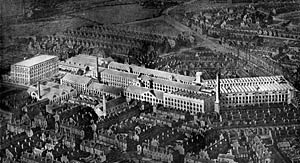
John Players factory in Radford in the early 1930s.
Today the trades of the city have an almost endless variety, and there are other firms besides Boots that have won for themselves a national or worldwide reputation. At a splendid factory covering five acres, Thomas Formans produce art calendars and printing that most people handle whether they know it or not. On Radford Boulevard are the palatial factories of John Player and Sons and the Raleigh Cycle Company, two vast concerns known the world over, each with a romantic story. In the last quarter of last century John Player bought a small tobacco factory in Broad Marsh and moved it to Radford, where it has now grown to 45 acres, half of which is used for the recreation of its 7000 people. It is said to be the biggest tobacco factory under one roof in the world, and turns out cigarettes in tens of millions every day. Also in the last quarter of last century a small factory in Raleigh Street was making two or three bicycles a week. Mr Frank Bowden, coming home a sick man from Hong Kong, bought one of them, rode it for six months in the Pyrenees, and came home strong and well, and with such faith in his bicycle that he started making cycles and has built up a firm which is second to none in the cycle world.
These are Nottingham's great trades today, though the city has fifty or a hundred more—building machinery and rolling stock for railways, bleaching, dyeing, brewing, electroplating, box making, leather dressing, making typewriters and perambulators and thermometers, producing fine chemicals, surgical appliances, soap and glue, glove fabrics, furniture, and bricks. Everywhere in its street names we are reminded of the old trades of the city. The wheelwrights lived in Wheeler Gate; Bridlesmith Gate and Smithy Row echoed with the clang of hammer and anvil. The tanners were in Barker Gate and the fur workers in Pilcher Gate.
Nottingham is rich in the opportunities it gives its people to enjoy their leisure, and to educate themselves in noble things. It has not only developed its castle on the lines we have seen, but has taken to itself the Elizabethan Wollaton Hall and the home of Lord Byron at Newstead. Wollaton Hall is a mile or so from the City Centre; Newstead is nine miles away.
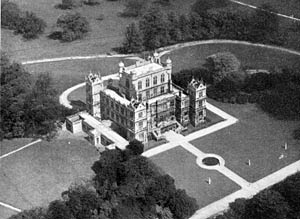
Wollaton Hall from the air in the early 1930s.
The great Natural History Museum of the town has been moved to Wollaton, so that this collection is as splendidly housed as any collection in the country. The Wollaton estate was sold to the city in 1924, thus bringing to an end an association between Wollaton village and the Willoughbys that had lasted 600 years. The Hall, which took eight years to build and cost £80,000 in Queen Elizabeth's coinage, was completed in Armada year, all the stone carried from Ancaster by donkey or packhorse and paid for with Wollaton coal. It is believed to have been designed by John Thorpe.
This great pile of ornamented stone, an impressive spectacle, has a variety of Gothic, Tudor, and classical styles, and is striking for its countless windows, pilasters, cornices, balustrades, and niches, in which are busts of Plato, Virgil, Aristotle, and Diana. A fine Prospect Room with projecting turrets crowns the centre block, and there are four square pavilions at the corners with Dutch gables and pinnacles. The great hall has a handsome stone screen and a hammerbeam roof. The museum housed here includes a collection of butterflies from China and Hong Kong, the Fowler collection of British beetles, and the Crauford collection of 25,000 insects.
The glory of Wollaton has always been its magnificent park, with 800 acres of plantations and groves and wonderful gardens. Here is said to have been built the first glasshouse in England for protecting plants. The park was enclosed by a brick wall five miles long, on which a boy served a seven-years' apprenticeship. The wall has been disturbed and the builder has been at work within it, but the deer still browse by the great lake in the woodland hollow, the gardens are still lovely to see, there is a cedar grove by a splendid flight of steps, a lime grove three-quarters of a mile long leading from the great stone gateway to the hall, and a marvellous house which is unforgettable when the camelias are in bloom; it is said that this house cost £10,000 to build. Looking out over all this from the fine leaded roof of the Prospect Room, we see Belvoir Castle 20 miles away.
Newstead Abbey, home of Lord Byron, once stood in the heart of Sherwood Forest, having been founded about 1170 by Henry the Second in his remorse for the death of Thomas Becket. After the Reformation it became one of England's great country houses, and Byron was the last of his line to possess it. It has an association with two men whose dramatic meeting in the Dark Continent was one of the immortal moments of the 19th century, for here David Livingstone stayed for a year, writing a book, and here came Sir Henry Stanley several times. Now it belongs to the city, the gift of Sir Julian Cahn, and it is one of the most enjoyable experiences a Nottingham citizen can give himself to walk through the acres of these enchanting gardens, and to wander through these rooms. One of the earlier owners, Mr Charles Ian Fraser, has given the city the Byron relics, the entrance lodge, the land on which stands the famous Pilgrim Oak, over 70 acres of the park, and the six-acre wood known as Poet's Corner. When the Abbey was dedicated to the city in 1931, Prime Minister Venizelos of Greece was present to pay tribute to the memory of the poet who died fighting for the liberty of Greece.
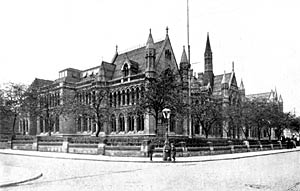
The former University College and central library in the early 1930s.
Next door to the old University College is Nottingham's central library, controlling the issuing of about a million volumes a year through its branches. It has on its stairway an oil painting of Homer singing at the gate of Athens, and on the landing is a framed facsimile of the death-warrant of Charles Stuart, with a print showing the king dictating his proclamation at the raising of the standard. The reading room has a collection of water-colours showing scenes in bygone Nottingham, including the Windmills on the Forest, the old Postern Gate in Middle Pavement, Wilford Ferry, and the old Trent Bridge. There is a portrait of James Prior Kirk (of Forest Folk fame) and one of William Booth by Denholm Davis. The library has a special lending department for the blind, and it has an interesting collection of rare books, among them the unpublished letters of Byron which were suppressed before publication and of which only ten copies were distributed, and the original manuscript of Robert Thoroton's Antiquities of Notts.
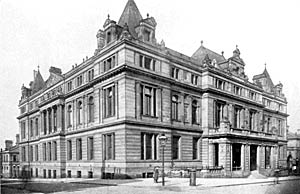
The Guildhall in the 1930s.
Close by is the Guildhall, part of an imposing block now under reconstruction, its entrance hall with classical columns and a rich ceiling. Not far away, in Goldsmith Street, is the Masonic Hall, a handsome new building with a frontage of 450 feet, and housed in an attractive building near by is the College of Art, the development of the School of Art, to which Dame Laura Knight, the second woman to be elected ARA, came as a schoolgirl of 13. Her first picture accepted by the Royal Academy now hangs at the castle. Her artist husband is a Nottingham man. So too were Paul and Thomas Sandby and Arnesby Brown. In the grounds of the College of Art is a statue of Richard Parkes Bonington, born on the outskirts of the city.
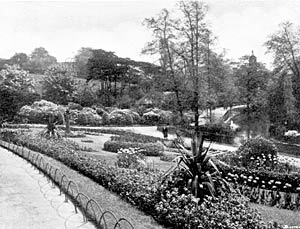
The Arboretum in the early 1930s.
Near to this notable College of Art is the Arboretum, a charming park of 19 acres of grassy banks, shady walks, and beds of flowers. Swans and water fowl swim on the bowery lake, and the gorgeous plumage of some of the birds make the aviaries an unfailing attraction. In a riot of flowers on a small hilltop stands a copy of a Chinese pagoda sheltering a bell captured at Canton by the Notts Regiment, and at the corners of the Pagoda are guns captured at Sebastopol. Along the paths close by is a statue of Feargus O'Connor, holding a scroll. He was local leader of the Chartists in the agitation for the Reform Bill, and sat for Nottingham in Parliament. In the middle of a stone seat near one of the gates is the fine bronze bust of Samuel Morley, whose marble statue used to stand outside the Theatre Royal, looking down into the marketplace; the statue was being moved for traffic purposes when it fell and broke into pieces. He was of the great hosiery family associated with Nottingham so long, and is still remembered for his philanthropic interest in the city. The bust in the Arboretum is by Mr Else, Principal of the College of Art.
Only a few hundred yards from the beautiful Arboretum is the great open space of the Forest. It is the city's oldest recreation ground, and its 70 acres were once part of Sherwood Forest. The old Goose Fair which used to be held in the marketplace is now held here.
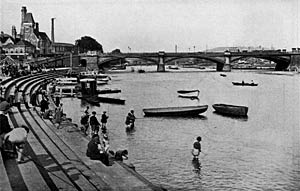
Trent Bridge and the Embankment in the 1920s.
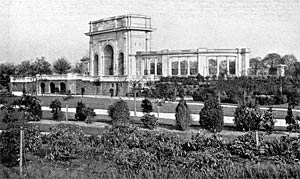
The War Memorial.
Thousands of city folk seek their recreation by the river, a most attractive place which may be taken as a model by many towns which waste their river banks. From time immemorial the crossing of the Trent at Nottingham has been an important link between north and south, but the first bridge of which we know was built of wood a thousand years ago. The medieval stone bridge had a chapel, and a shallow arch of it still remains at the southern end of the present bridge, which was built in 1870 and widened in our own time. It has now three iron arches on stone piers, and is 80 feet wide between the parapets. From this bridge to Wilford Toll Bridge a magnificent promenade runs for over a mile, covering 28 acres, shaded first by fir trees and then by limes. On one hand is green lawn, a fine flight of steps, and the river gay with pleasure boats; on the other hand wide playing-fields, green spaces, lovely gardens, and a noble monument to the thousands of Nottingham men who fell in the war. It was designed by the City Engineer, Mr Wallis Gordon, and has a stately triple archway, with colonnaded wings embracing lawn and shrubs and balustraded terraces continuing across the boulevard to the river. The iron gates are enriched with scrolls of the city arms, and along the top of the gateway is the city's motto, Virtue is Immortal. There is a fine view of the city from the embankment, and through the memorial gateway we come to lawns and flowers, trees and shrubs and rockeries, set about a lily pool like an ornamental cross.
A little way off, on the West Bridgford side of the river, is the famous ground of the Notts County Cricket Club, where have been cradled so many players of renown; and here, too, is Sir Julian Cahn's cricket ground and a famous football ground.
